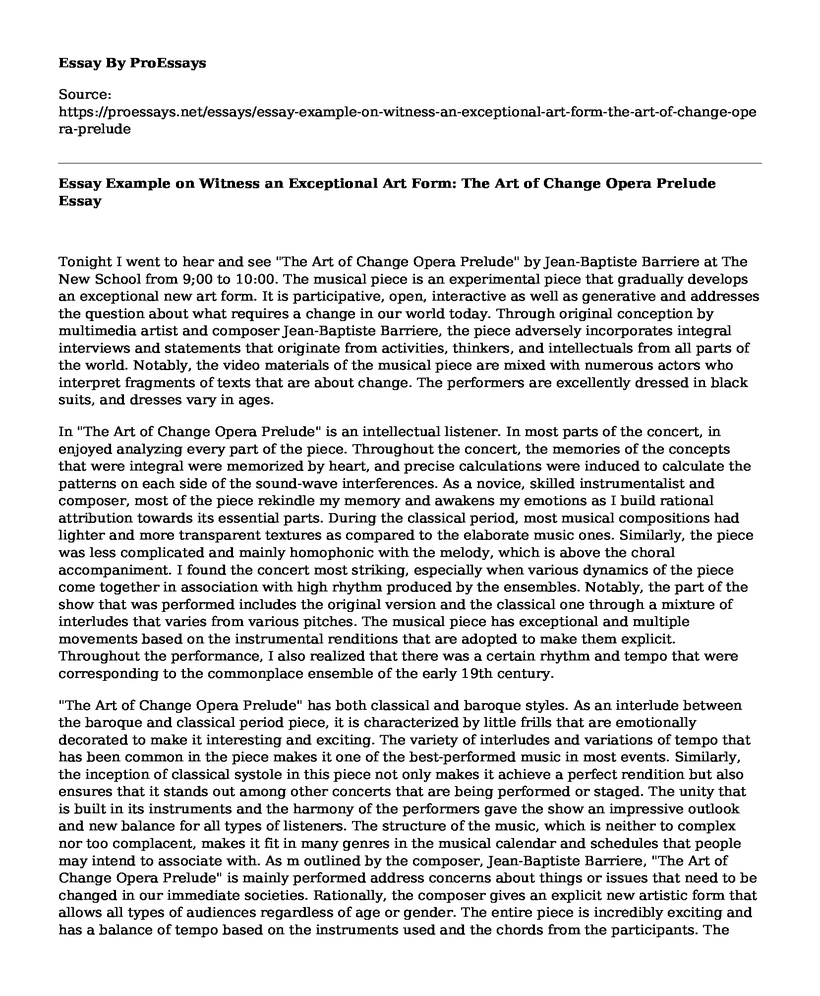Tonight I went to hear and see "The Art of Change Opera Prelude" by Jean-Baptiste Barriere at The New School from 9;00 to 10:00. The musical piece is an experimental piece that gradually develops an exceptional new art form. It is participative, open, interactive as well as generative and addresses the question about what requires a change in our world today. Through original conception by multimedia artist and composer Jean-Baptiste Barriere, the piece adversely incorporates integral interviews and statements that originate from activities, thinkers, and intellectuals from all parts of the world. Notably, the video materials of the musical piece are mixed with numerous actors who interpret fragments of texts that are about change. The performers are excellently dressed in black suits, and dresses vary in ages.
In "The Art of Change Opera Prelude" is an intellectual listener. In most parts of the concert, in enjoyed analyzing every part of the piece. Throughout the concert, the memories of the concepts that were integral were memorized by heart, and precise calculations were induced to calculate the patterns on each side of the sound-wave interferences. As a novice, skilled instrumentalist and composer, most of the piece rekindle my memory and awakens my emotions as I build rational attribution towards its essential parts. During the classical period, most musical compositions had lighter and more transparent textures as compared to the elaborate music ones. Similarly, the piece was less complicated and mainly homophonic with the melody, which is above the choral accompaniment. I found the concert most striking, especially when various dynamics of the piece come together in association with high rhythm produced by the ensembles. Notably, the part of the show that was performed includes the original version and the classical one through a mixture of interludes that varies from various pitches. The musical piece has exceptional and multiple movements based on the instrumental renditions that are adopted to make them explicit. Throughout the performance, I also realized that there was a certain rhythm and tempo that were corresponding to the commonplace ensemble of the early 19th century.
"The Art of Change Opera Prelude" has both classical and baroque styles. As an interlude between the baroque and classical period piece, it is characterized by little frills that are emotionally decorated to make it interesting and exciting. The variety of interludes and variations of tempo that has been common in the piece makes it one of the best-performed music in most events. Similarly, the inception of classical systole in this piece not only makes it achieve a perfect rendition but also ensures that it stands out among other concerts that are being performed or staged. The unity that is built in its instruments and the harmony of the performers gave the show an impressive outlook and new balance for all types of listeners. The structure of the music, which is neither to complex nor too complacent, makes it fit in many genres in the musical calendar and schedules that people may intend to associate with. As m outlined by the composer, Jean-Baptiste Barriere, "The Art of Change Opera Prelude" is mainly performed address concerns about things or issues that need to be changed in our immediate societies. Rationally, the composer gives an explicit new artistic form that allows all types of audiences regardless of age or gender. The entire piece is incredibly exciting and has a balance of tempo based on the instruments used and the chords from the participants. The volume of the musical composition was neither high nor low but was moderate enough to give listeners a pleasant likeness of the entire concert. Due to its mixture of both old and new styles in a balanced manner, the pitch is coherently maintained.
The most prevalent instrument in the "The Art of Change Opera Prelude" is a flute for acoustic rendition. Flutes of different sizes and shapes were being used by performers to give and outstanding rhythm and harmony throughout the concert. The leading performers are balances the pipes to provide the piece with an exciting through the orchestra performance. However, based on the seating arrangement, the concert has a pleasant outlook, and both the performers and the listeners or audience had their places in the hall. On the upper stage were three larger flutes on one corner to the right while the performer, main characters, male and female seated on the left. Below, on the immediate upper stage platform, other performers with different playing instruments with unique voices lines in a semi-circular circle. Those were eight in total while the listeners and other audiences are seated some meters from the front stage facing the performers with a string separating them from each other. Children were given the front seats to allow access to the entire processions and performance. The concert included all elements of music in the production, though the one that attracted me most was the jazz harmonies. Overall, the long, agile melodic lines of the piece that are intertwined in a conceptual texture gave the concert an incredible sound.
Work Cited
https://vimeo.com/365442696
Cite this page
Essay Example on Witness an Exceptional Art Form: The Art of Change Opera Prelude. (2023, Mar 26). Retrieved from https://proessays.net/essays/essay-example-on-witness-an-exceptional-art-form-the-art-of-change-opera-prelude
If you are the original author of this essay and no longer wish to have it published on the ProEssays website, please click below to request its removal:
- Film Analysis Essay on Rocky
- Case Study: Psychological Assessment Tool and Evidence Intervention for Russell Todd in the Movie "Beaconsfield"
- Creating Awareness About Immunizations Paper Example
- Analysis of the "Meet the Press" Television Show Featured on NBC News
- Requirements of a Legally Binding Contract Under the English Law - Essay Sample
- Essay Example: 'A Talk to Teachers' by James Baldwin
- Urban Decay and Alienation in Taxi Driver (1976) - Essay Sample







